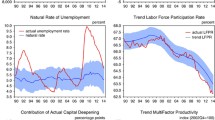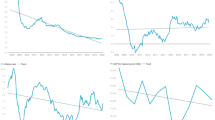Abstract
We investigate whether the United States economy responds asymmetrically to positive and negative money supply shocks of different magnitude, using a test recently introduced by Kilian and Vigfusson (Quant Econ 2:419–453, 2011) based on impulse response functions. We use quarterly data, over the period from 1967:1 to 2014:1, and the new CFS Divisia monetary aggregates, making a comparison among the narrower monetary aggregates, M1, M2M, MZM, M2, and ALL, and the broad monetary aggregates, M4+, M4-, and M3. We show that there is no statistically significant evidence of asymmetry in the response of the U.S. economy to positive and negative money supply shocks of different magnitude.








Similar content being viewed by others
References
Anderson RG, Chauvet M, Jones B (2015) Nonlinear relationship between permanent and transitory components of monetary aggregates and the economy. Econ Rev 34:228–254
Barnett WA, Chauvet M (2009) International financial aggregation and index number theory: a chronological half-century empirical overview. Open Econ Rev 20:1–37
Barnett WA, Liu J, Mattson RS, van den Noort J (2013) The new CFS Divisia monetary aggregates: design, construction, and data sources. Open Econ Rev 24:101–124
Belongia MT, Ireland PN (2014) The Barnett critique after three decades: a new Keynesian analysis. J Econ 183:5–21
Belongia MT, Ireland PN (2015a) A ‘working’ solution to the question of nominal GDP targeting. Macroecon Dyn 9:508–534
Belongia MT, Ireland PN (2015b) Interest rates and money in the measurement of monetary policy. J Bus Econ Stat 33:255–269
Chrystal KA, MacDonald R (1994) Empirical evidence on the recent behavior and usefulness of simple-sum and weighted measures of the money stock. Federal Reserve Bank of St. Louis. Review 76:73–109
Cover JP (1992) Asymmetric effects of positive and negative money-supply shocks. Q J Econ 107:1261–1282
DeLong JB, Summers LH (1988) How does macroeconomic policy affect output? Brook Pap Econ Act 2:433–494
Florio A (2004) The asymmetric effects of monetary policy. J Econ Surv 18:409–426
Friedman M (1960) A program for monetary stability. Fordham University Press, New York
Friedman M (1968) The role of monetary policy. Am Econ Rev 58:1–17
Friedman M, Schwartz A (1963) A monetary history of the United States, 1867–1960. Princeton University Press, Princeton
Hamilton JD (2003) What is an oil shock? J Econ 113:363–398
Hendrickson JR (2014) Redundancy or mismeasurement? A reappraisal of money. Macroecon Dyn 18:1437–1465
Jadidzadeh A, Serletis A (2015) The demand for liquid assets and optimal monetary aggregation: evidence from a disaggregated demand system based on the NQ expenditure function. University of Calgary, Mimeo
Kandil M (1995) Asymmetric nominal flexibility and economic fluctuations. South Econ J 61:674–95
Karras G (1996) Are the output effects of monetary policy asymmetric? Evidence from a sample of European Countries. Oxf Bull Econ Stat 58:267–278
Kilian L, Vigfusson RJ (2011) Are the responses of the U.S. economy asymmetric in energy price increases and decreases?. Quant Econ 2:419–453
Ravn MO, Sola M (2004) Asymmetric effects of monetary policy in the United States. Federal Reserve Bank of St. Louis. Review:41–60
Serletis A, Gogas P (2014) Divisia monetary aggregates, the great ratios, and classical money demand functions. J Money Credit Bank 46:229–241
Serletis A, Koustas Z (2015) Monetary neutrality. Macroecon Dyn. forthcoming
Serletis A, Rahman S (2009) The output effects of money growth uncertainty: evidence from a multivariate GARCH-in-Mean VAR. Open Econ Rev 20:607–630
Serletis A, Rahman S (2015) On the output effects of monetary variability. Open Econ Rev 26:225–236
Simons HC (1936) Rules versus authorities in monetary policy. J Polit Econ 44:1–30
Tavlas GS (2015) In old Chicago: Simons, Friedman and the development of monetary policy rules. J Money Credit Bank 47:99–121
Thoma MA (1994) Subsample instability and asymmetries in money-income causality. J Econ 64:279–306
Weise CL (1999) The asymmetric effects of monetary policy: a nonlinear vector autoregression approach. J Money Credit Bank 31:85–108
Author information
Authors and Affiliations
Corresponding author
Additional information
We would like to thank Lutz Kilian and a referee for useful comments and suggestions that greatly improved the paper.
Rights and permissions
About this article
Cite this article
Serletis, A., Istiak, K. Are the Responses of the U.S. Economy Asymmetric to Positive and Negative Money Supply Shocks?. Open Econ Rev 27, 303–316 (2016). https://doi.org/10.1007/s11079-015-9374-8
Published:
Issue Date:
DOI: https://doi.org/10.1007/s11079-015-9374-8




